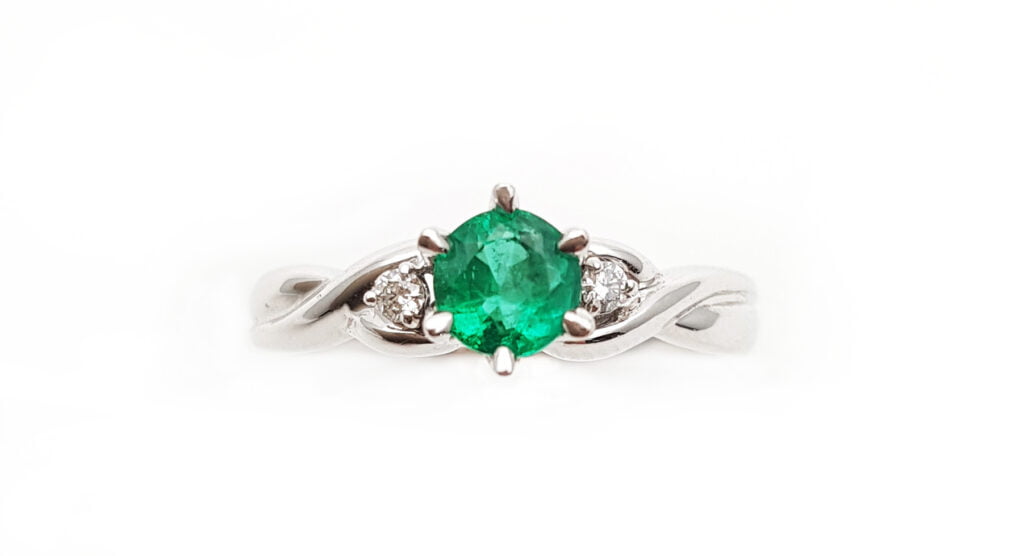May Birthstone: Emerald
Emerald is one of the most revered gemstones in the world for a long period extending to over 5000 years. Ancient civilisations such as ancient Egypt, Spanish Conquistadors, and India’s Mogul Empire all have admired the lush landscape green of emerald. In fact, few significant places and objects have used the term ‘emerald’ to describe its colour. For example: Emerald Isle is the poetic name for Ireland, and a Thailand’s religious icon is called Emerald Buddha despite the fact that it is carved from green jasper.

Until the sixteenth century, Egypt was a major source of emerald before the discovery of the New World, modern-day Colombia. Egyptian emeralds mostly highly fracture and color usually low in tone and saturation. Nevertheless, it did not prevent the affection of emerald for the Egyptian queen Cleopatra herself and much later grew in popularity in Europe. More so, early Romans writers referred to the Egypt mining area as “Mons Smaragdus”, which means “Emerald Mountain”.
The most famous member of the large and diverse beryl family; which consists of the blue aquamarine, pink morganite, yellow heliodor, and colourless goshenite, emerald has set the standard for green among other gemstones. It has also been assigned as the birthstone for May.

Beryl is made up from beryllium, aluminium, and silicate. Beryllium itself is a rare element on Earth, but to create emerald it must have the presence of chromium or vanadium for its green colouration. Most of the time, emerald contains traces of iron that gives its bluish tone. If the content of chromium or vanadium is higher, the greener it gets. Whereas if the iron is high the bluer it gets, and vice versa. Today, even though bluish-green emeralds are still highly desirable but pure intense green remains coveted. Still, what would make an emerald even irresistible would be its clarity.
To find a gemstone without imperfection is rare, emerald makes no exception. Besides, almost all emeralds have numerous inclusions that are eye visible to the naked eye. Why they are heavily included may be due to the fact of their formation process or harsh methods used to mine the gem.
Due to that matter, it is perfectly fine to acknowledge the presence of inclusions in the emerald whether you are a trader or a customer. It is frequently described as “jardin”, the French word for garden, a perfect illustration for those mossy-like inclusions. Additionally, the ‘garden’ proves to be a good evidence for a natural emerald because synthetic emeralds tend to be large in size and clean in clarity.


In spite of accepting the presence of inclusion, if the emerald contains densely-packed fractures or fissures, it might jeopardize the structural integrity of the stone thus making it unsuitable for usage. To counter that issue, a practice called oiling is introduced. Oiling can be known as fracture filling. But instead of glass and lead, traders would mostly use colourless natural or sometimes synthetic oil or resin. To find an untreated emerald with excellent clarity is extremely rare.
Besides the garden inclusions, in the microscopic world of emerald contains my favorite inclusion that is the three-phase inclusion. Within a three-phase inclusion contains three different matters: solid, liquid, and gas. While the presence of this inclusion in the emerald proves to be solid evidence for its nature, it is uncommon to find it in other gemstones. To find its presence however is challenging, but that is what makes gemology fun and worthwhile.
Historically speaking, Columbia has been the producer of the highest quality and volume of emerald. Although now competition from Brazil and up and coming Zambia, the finest emeralds from Columbia are still being the standard against which stones from other countries are judged.
The trade has seen many synthetic gemstones ever since it entered the market in the early 1900s. The purpose of gemstones synthesis varies from industrial, technology, or merely for profit. Emerald, as part of the ‘big three’ of coloured stone besides ruby and sapphire, the ‘big three’ has contributed more economic activity than all other coloured stones combined. Even more so, more dollars’ worth of emeralds was imported than sapphire and ruby combined in the USA (geology.com, USGS Mineral Yearbook 2015).
View our Emerald collection here: https://www.fareastgemsjewellery.com/collections/all-gemstones/emerald
Remember to subscribe to our monthly e-newsletter. For latest updates on The Gem Museum, follow us on Facebook or Instagram.
2020 Copyright – May Birthstone: Emerald, Andrew Neo, 11th May 2020.


